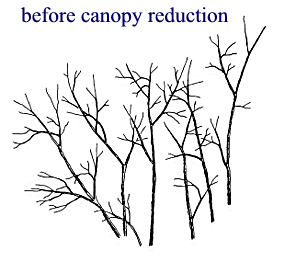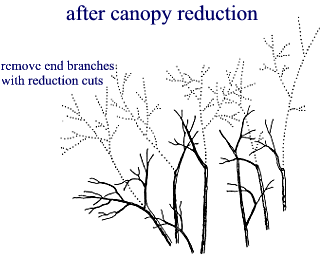Home > Pruning shade trees > Reducing the canopy
Reducing the canopy
| View illustrations below as an animation Examples of reducing canopy size Reducing canopy spread or over-extended limb Pollarding Topping trees Printer-friendly (2 page pdf) |
 |
Objectives
There are two main objectives of reduction pruning 1) reduce risk of failure; 2) provide clearance from a structure
|
This is a portion of the top of a tree showing six main branches before canopy reduction. Appropriate canopy reduction removes branches and stems from the outer portion of the canopy back to lateral branches at least one-third the diameter of the removed stems or branches. Some people refer to this as lateral pruning because you prune back to a lateral branch. |
This is the same portion of the tree at left with the end section of the branches removed with reduction cuts to reduce the size of the tree. Removed branch sections are shown as dotted lines. Note that there are live, unpruned branches left on the edge of the new, smaller canopy, and no heading cuts were used. Properly done, this provides a more pleasing, unpruned natural look to the tree compared to topping. Many people would not know a canopy was reduced in size following appropriate moderate canopy reduction. |
Introduction
Trees sometimes grow larger than desired for aesthetic or safety considerations. These trees may interfere with overhead utility wires, grow into buildings or other trees, or become hazardous because of their size, branch length, or condition. Reduction pruning is used to reduce the size of a tree by decreasing the length of one or many stems and branches. Although this type of pruning can control tree size to a certain degree, it is no substitute for matching the correct tree species with the site when planting. Moreover, the foliage and branches often grow back quickly, so once a tree is reduced, it should be kept in a reduced condition in perpetuity. Regular pruning will be required to maintain the tree within desired limits. Big trees planted in small places often require reduction to reduce risk of failure or reduce hardscape damage from roots. Storms often break or overturn the largest trees on a property, so reduction of these can be a good method of preserving them.
Reduction pruning
performed after the tree has become too large could require the removal of large
diameter stems. The resulting wounds can be accompanied by decay, cracks, and
sprout development. Therefore, it is preferable to perform reduction before
the tree has become too large for its environment. Proper reduction pruning
reduces size while more-or-less maintaining a tree's form and minimizes regrowth.
Execution
Sometimes the entire canopy of a tree must be reduced in height or spread, such as for utility line clearance or to minimize risk of failure. In addition to the size of parts to be removed, be sure to specify the clearance required above or along side of the canopy when pruning near a building or for utility line clearance. That way, everyone will have the same understanding of what is to be performed. Portions of the canopy, such as individual limbs, can be reduced in order to balance the canopy or to reduce likelihood of breakage on limbs with defects such as cracks and included bark or those that have grown to become too long.
Reduction is best accomplished by cutting limbs back to their point of origin or back to a lateral branch capable of sustaining the remaining limb and assuming apical dominance of the limb (this is referred to as a reduction cut). A common rule of thumb is that the remaining lateral branch must be at least one-third the diameter of the removed portion, but this rule can vary with species, age, climate, and the condition of the tree. Heading cuts are less preferred but are sometimes necessary on certain branches ir order to meet objectives.
Consideration must also be given to the ability of the species to sustain this type of pruning. Species that are known to decay quickly from these types of cuts should be reduction pruned more conservatively than more decay resistant species. Trees reduced by topping look terrible and can cause significant decay. Topping also produces numerous sprouts, cracks in limbs, root decline, bark defects, and other problems.



